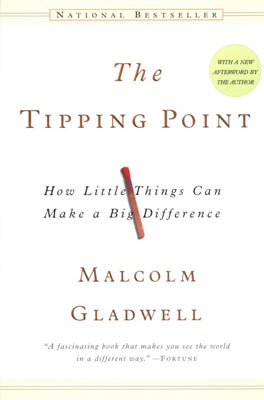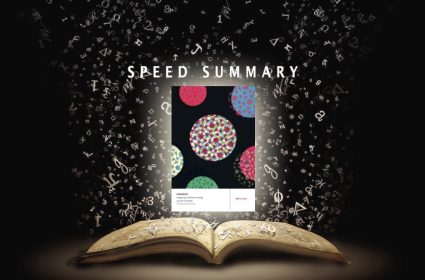The Tipping Point Speed Summary

 The Tipping Point: How Little Things Can Make a Big Difference
The Tipping Point: How Little Things Can Make a Big Difference- Author: Malcolm Gladwell
- Publisher: Little Brown
- Publication date: 2000
The Tipping Point has gained something of a cult status in marketing – as the black book of 21st Century Marketing. But what does Malcolm Gladwell’s influential bestseller actually advocate, and how can it be applied to real world marketing?
The Tipping Point is a book about how hits happen. Using the science of epidemics, Gladwell shows how small actions at the right time, in the right place, and with the right people can create a ‘tipping point’ for a product – the moment when a domino effect is triggered and an epidemic of demand sweeps through a population like a virulent virus. For example, Hush Puppies ‘tipped’ in 1993, when a few fashion-forward hipsters from Soho New York started wearing the languishing brand again. This triggered a chain reaction that cascaded though the US, increasing sales 70-fold and creating a word of mouth epidemic. Using the three basic laws of epidemics, Gladwell outlines a simple three-point plan to get your product to its own tipping point.
1. The Law of the Few
An epidemic begins when a few highly infectious individuals become viral vectors for a product or idea by adopting it themselves and spreading the word. Gladwell identifies three key types of infectious opinion leaders with whom you should seed your product at launch:
- Mavens are opinion leading consumer experts who spread influence by sharing their knowledge with friends and family. Mavens are gate-keepers of innovation diffusion because their adoption patterns are respected by peers as informed decisions.
- Connectors are a second type of opinion leading consumer, deriving their influence not through expertise, but by their position as highly connected social network hubs. As centres of social gravity, around whom people cluster, connectors are popular people who have a viral capacity to showcase and advocate new products.
- Salesmen are the third type of opinion leading influencer, people with the power of persuasion. They are naturally charismatic and contagious consumers – who often work in sales – whose enthusiasm rubs off on those around them.
2. The Stickiness Factor
An epidemic spreads when the contagious agent, the product, is naturally infectious, or ‘sticky’ to use the broadcasting term. A show is ‘sticky’ when we don’t want to switch channels, and Gladwell gives examples from television and books to show how small tweaks to increase relevance, talk-ability and memorability can have a massive effect on success. Although he does not address consumer products more generally, the recent meta-analysis of a wide range of cult brands in the Journal of Product Management (2000) shows us the ten critical factors that make any product sticky or infectious:
- Uniqueness: clear one-of-a-kind differentiation
- Aesthetics: perceived aesthetic appeal
- Association: generates positive associations
- Engagement: fosters emotional involvement
- Excellence: perceived as best of breed
- Expressive value: visible sign of user values
- Functional value: helps goal attainment
- Nostalgic value: evokes sentimental linkages
- Personification: has character, personality
- Cost: perceived value for money
The implication from The Tipping Point is that we should develop products to fit this ‘sticky’ profile, because these are the critical success factors that can have a massive impact on sales.
3. The Power of Context
Finally, the spread of an epidemic will depend on whether the context is right. Ideas and products that fit the context into which they are launched spread fast and wide, whilst others that don’t fit their context, don’t spread. For example, a wave of crime in the New York subway was halted by simply removing the graffiti from trains and clamping down on fare-dodging. The context changed and so did the people. This power of context provides marketers with a powerful new strategy for the development of new products: Target contexts before you target consumers. Consumers are contextual chameleons and will adopt your product if it fits the context, situation or occasion in which they find themselves. It also means that consumers are more highly susceptible to influence at the point of purchase than we might think – underlining the critical importance of Point of Purchase promotions and personal selling. Whilst volume and price promotions will always work well in the purchase context, think about how you could integrate the six psychological principles of influence into promotions and promotional materials.
- Scarcity: Our minds are hardwired to value scarce resources, so limit availability of the promotion or your product
- Majority: The herd instinct is very much alive, so use the power of lists to show how your product is no 1, and watch the crowds follow
- Authority: The brain is automatically predisposed to copying the behaviour of authorities, so show how your product is the preferred choice of category authorities
- Beauty: We may not like it but we have an automatic reflex to think good looking people make good choices – so associate your product with the choices of beautiful people
- Reciprocity: We have evolved to reciprocate favours, so do something for the buyer, and improve your chances of getting bought
- Consistency: The human mind automatically prefers to be consistent with past choices, so show how your product is consistent with the choices they’ve already made
So there you have it, the three-point Tipping Point plan for creating a hit: “The Law of the Few”, “The Stickiness Factor” and “The Power of Context”. Does the formula work? First results are very encouraging with Unilever, Procter & Gamble, Ford, Pepsi, Microsoft, Siemens and Apple all significantly accelerating sales with Tipping Point initiatives. Already adopted as the 21st century cult book of marketing, The Tipping Point is providing marketers with an exciting new approach to the successful development and launch of innovations.




